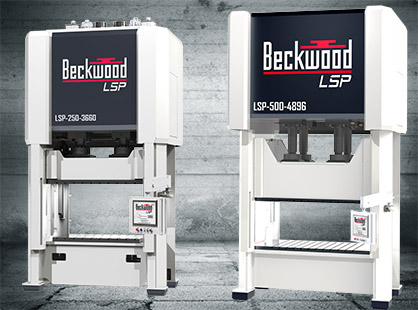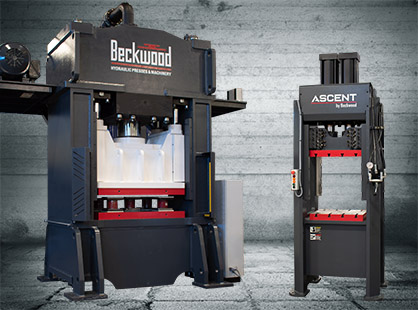Standard Servo Presses
Beckwood offers two standard servo press lines with the widest range of tonnages for any electro-mechanical press today: EVOx™ Servo-Electric Presses & LSP™ Linear Servo Presses. The EVOx™ line is ideal for low-tonnage, high-precision applications. With standard c-frame and 4-post servo press models ranging from 2.5 – 50 tons and custom offerings up to 100 tons, EVOx offers the the highest degree of positional repeatability (within ±0.0005″) while offering force and positional feedback at a rate of 1 sample per millisecond. The Beckwood LSP™ line uses patented gearbox technology and servo motors to achieve the highest degree of forming flexibility at production-level speeds. With standard models ranging from 125 – 500 tons, Beckwood LSP™ offers the highest tonnage capacity of any electro-mechanical press available today.
Custom Servo Presses
If your press needs fall outside of our standard lines, we also offer fully custom servo presses with up to 500 tons of force. Bed size, speed, tonnage, frame style, heating systems, and more can be tailored to your exact needs. You’ll also get the intuitive controls package that accompanies all of our servo machines. No other OEM offers a wider tonnage range on fully-electric servo press systems. Contact us for a custom quote today!
Servo Press Benefits
As manufacturing facilities and assembly plants continue to evolve and become more efficient, so does press technology. Today, servo presses are becoming increasingly popular in both high-precision and more ‘traditional’ pressing applications alike. Here’s why:
- Precision Forming – A servo press offers the highest level of accuracy and precision of any press available.
- Full Tonnage Throughout the Stroke – Servo presses can initiate maximum pressing force at any point throughout the stroke. This allows you to control several cycle parameters including travel distance, pressure, and return position. It also eliminates BDC (bottom dead center) issues associated with servo-mechanical presses.
- Improved Part Quality – A servo press creates tighter tolerances and less waste because the actuator adjusts automatically throughout the cycle via force feedback that’s inherent to the servo technology. Additionally, part contamination due to hydraulic leaks is eliminated. Together, these features can reduce scrap rates by up to 80% compared to hydraulic or servo-mechanical presses.
- Clean – Since servo presses run entirely on electricity, hydraulic fluid is not required. Not only does this eliminate leaks and costly disposal fees, it ensures that cleanliness requirements are maintained for meticulous environments like labs and clean rooms.
- Easy Maintenance – Without hydraulic systems or mechanical crankshafts and flywheels, servo presses require fewer components to achieve force. This makes them much easier to maintain and support than servo-mechanical presses or hydraulic presses. A Beckwood servo press can run millions of cycles before maintenance is ever required.
- Standard Components – Multi-axis servo controllers, small servo motors, and drive systems are readily available from most modern suppliers, so if replacement is required, downtime is minimal.
- Energy Efficient – A large amount of electricity is required to power a hydraulic system, even when the press is idle. Additionally, hydraulic systems generate heat which must be controlled to avoid undue stress on the system. A servo press uses energy on-demand, yielding energy and cost savings of up to 70%.
- Long Life – Using roller screw actuators ensures Beckwood servo presses last up to 15 times longer and achieve greater load capacity than ball screw servo presses.
- Less Noise – Motors and pumps that drive a hydraulic power unit can exceed 90 decibels. Eliminating the HPU and its components and only using power when the press is operating (on-demand), servo presses maintain a very low ambient noise level.
ARTICLE: The growing popularity of Servo Press Technology
ARTICLE: Linear Servo Presses Find Roles in Automotive Manufacturing
WHITEPAPER: Hydraulic vs. Servo Presses
Introduction
In a hydraulic press, hydraulic fluid is pumped and pressurized to create the desired force, speed, and motion of the ram and any ancillary equipment (shuttles, knockout cylinders, booking rams, etc.). Conversely, a servo-electric press uses individual electro-mechanical (roller screw or ball screw style) actuators and servo motors / drives to perform each desired operation within the cycle.
While much has been written about the benefits of servo-electric presses, they are not always the best solution. Both forms of actuation have strengths and weaknesses, and choosing the right one for your application depends on a number of factors. This whitepaper explores the primary differences between the two technologies and offers recommendations for successful implementation based on the factors most important to you.
Position & Force Control
Both hydraulic and servo-electric presses have fully adjustable stroke profiles and can achieve maximum pressing force at any point throughout the stroke. This allows you to program the machine to adapt to different tool shut heights and perform “short cycle” strokes when desired (in a coil-fed punching application, for example), while also maintaining the flexibility to be used in deep draw or powder compacting applications.
Programmable electro-mechanical actuators ensure accuracy and positional repeatability to within +/- 0.0005” and force control to within +/- 0.5% or better. They also offer instant feedback for diagnostics and maintenance, as well as built-in data acquisition to record and measure torque, force, position, speed, and time at a rate of 1 sample / ms.
While the accuracy of hydraulic systems has improved (both from a position and pressure control standpoint) due to the increased use of proportional/servo valves and high-speed motion controllers, applications requiring high precision and force control are still better suited for a servo-electric press.
Tonnage Requirements
Currently, most electro-mechanical actuators are limited to approximately 50 tons of force each. Although they can be arranged in series to accommodate higher-tonnage applications, groupings are typically limited to four because the increased component cost as well as the increased space required within the press’ footprint to accommodate multiple actuators often aren’t realistic for most manufacturers. For this reason, applications which require force beyond 200 tons are typically better suited for a hydraulic press.
Due to the inherent flexibility of a fluid power system, hydraulic presses can be easily scaled to accommodate both low and high-tonnage applications without greatly impacting the overall footprint.
Forming Flexibility
Some applications require more flexibility in their forming equipment than others. For example, are you developing a new, cutting-edge manufacturing process or forming a new material? Are you working in a lab or clean room environment or a high-end manufacturing facility? If so, you do not want to be limited by traditional hydraulic equipment. Servo-electric presses are the most flexible, highest performing, and cleanest machines available today.
 Carbon Footprint
Carbon Footprint
While the cost of electricity in many locations has doubled or tripled over the last decade, so has the number of companies implementing green initiatives to reduce energy consumption, emissions, and other forms of pollution.
A large amount of electricity is required to power a hydraulic system, even when the press is idle. Some energy-efficient technologies like variable frequency drives (VFDs), pneumatic dwell systems, and soft starters are available for hydraulic presses, but even with these features, hydraulic presses still consume significantly more energy than their electro-mechanical counterparts. Servo-electric presses, however, only use energy on-demand, yielding a 20-50% energy savings depending on usage and duty cycle.
Because servo-electric presses run entirely on electricity, oil is not required. Not only does this reduce the number of components needed to run the system, it eliminates costly leaks and disposal fees and ensures that cleanliness requirements are maintained for meticulous environments like labs, clean rooms, and food processing plants.
Motors and pumps that drive a hydraulic power unit can exceed 90 decibels. By eliminating the HPU and its components and only using power when the press is operating (on-demand), servo-electric presses maintain a very low ambient noise level, virtually eliminating noise pollution. On average, noise levels are typically 30% lower with servo-electric systems.1
Maintenance
The best way to prevent unplanned downtime with any piece of forming equipment is to follow its factory-recommended preventive maintenance schedule with internal personnel, or hire the OEM under a service contract to perform the maintenance for you. For hydraulic presses, this includes performing oil changes, checking and replacing hydraulic lines and fittings, maintaining oil cleanliness, monitoring particulate counts, and reviewing press performance data to uncover inefficiencies. If your facility has in-house maintenance personnel familiar with the on-going needs of a fluid power system, these tasks can be relatively simple, inexpensive, and routine.
However, if your maintenance team is less experienced with hydraulics or you don’t have in-house maintenance capabilities, a servo-electric press is the better choice. Servo-electric presses require very little maintenance over time. Without oil tanks, pumps, valves, and hoses, servo-electric presses require fewer components to achieve force. This makes them much easier to maintain and support compared to hydraulic or mechanical flywheel systems. Additionally, quick-connect cables on servo-electric presses install in a fraction of the time it takes to plumb a hydraulic system and are frequently used in “plug-and-play” environments.2 Depending on the application and duty cycle, they can go 15 years or more without performing any factory recommended maintenance.3
Cost of Acquisition vs. Cost of Ownership
Typically, hydraulic presses have a lower upfront cost of acquisition than servo-electric presses, so the savings from lower operating costs and improved part quality long-term are often overlooked on servo-electric machines. The amount of time it takes to achieve full ROI on an electro-mechanical system will vary depending on your application, usage requirements, and utility costs, but it is not uncommon to see payback in as little as one year.4
Due to their high accuracy and advanced data acquisition capabilities, servo-electric presses can also be used to perform “in-press” quality checks. The ability to verify part quality during the cycle often allows a downstream quality check to be eliminated and should be factored into ROI calculations for this technology.
In a fluid power system, one pump and reservoir can power multiple actuators. This results in additional upfront cost savings for applications which require ancillary operations like knockout cylinders, draw cushions, shuttles, clamps, etc.
If upfront cost is most important to you and/or you have multiple ancillary operations within your cycle, then a hydraulic press is the best choice. If long-term energy savings and improved part quality are your deciding factors, then a servo-electric press is the best choice.
Safety
Operating temperatures on a hydraulic press are much higher than servo-electric due to the nature of hydraulic fluid which heats up when it’s being pumped throughout the system. If not cooled properly, this could cause premature component failure. When a high-pressure hose leaks or bursts on a fluid power system, it creates an unsafe work environment for the operator and maintenance staff.
When performing applications that require heated platens (hot forming, SPF, compression molding, etc.), servo-electric presses are the safer choice. Since oil is not required to generate force in an electro-mechanical system, it is much less of a fire hazard when working with increased temperatures.
Conclusion
Whether you’re developing a new forming process or you simply want to improve an existing one, choosing the right equipment is paramount to your success. Both hydraulic and servo-electric presses offer a variety of advantages and disadvantages that could be the deciding factor for your purchase. Before choosing any kind of press, it is important to understand your production goals, application requirements, safety objectives, maintenance capabilities, and efficiency standards and choose an OEM that can customize the machinery to meet your exact needs.
References
- Curtiss-Wright Industrial Group. (2019). Benefits of Electric over Hydraulic Actuation. Exlar Corporation. 1-6. https://www.cw-actuation.com/Resources/Exlar-Resources/Why-Choose-Electric
- Curtiss-Wright Industrial Group. (2019). Benefits of Electric over Hydraulic Actuation. Exlar Corporation. 1-6. https://www.cw-actuation.com/Resources/Exlar-Resources/Why-Choose-Electric
- Curtiss-Wright Industrial Group. Benefits of Exlar Electric Cylinders over Hydraulic Cylinders. Exlar Corporations. https://www.cw-actuation.com/Resources/Exlar-Resources/Benefits-of-Electric-Cylinders-over-Hydraulic-Cyli
- Manufacturing.net. (2012, May 9). “Hydraulic vs. Electromechanical Actuators. Manufacturing.net. https://www.manufacturing.net/industry40/article/13240822/hydraulic-vs-electromechanical-actuators


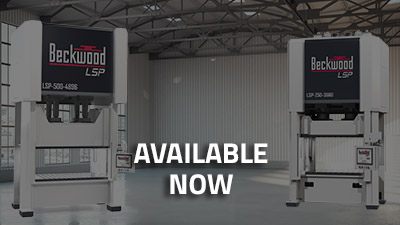
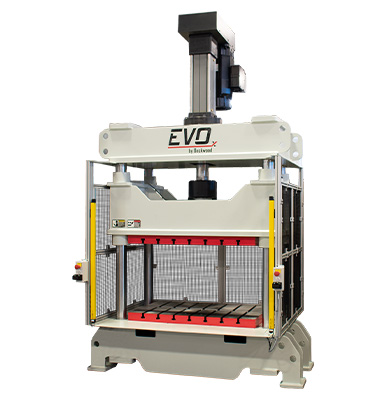
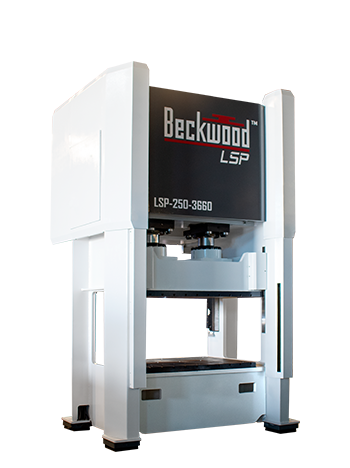 Carbon Footprint
Carbon Footprint 
